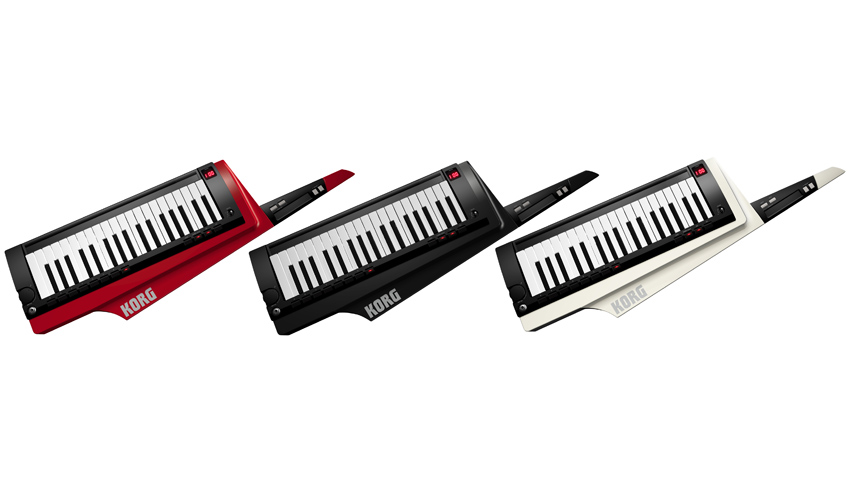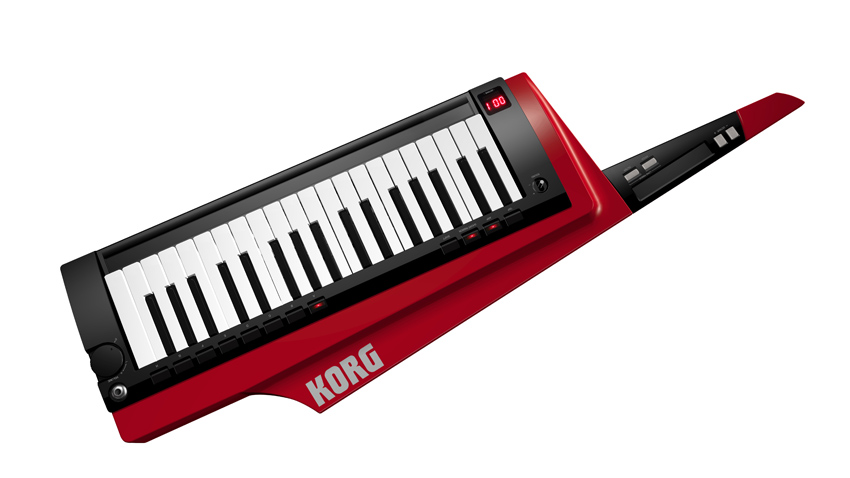NAMM 2014 VIDEO: Korg announces RK-100S keytar
New strap-on contains analogue-modelled sounds

Korg RK-100S

Korg RK-100S

Korg RK-100S

Korg RK-100S
NAMM 2014: Five years after Roland revived the keytar with the AX-Synth, Korg is putting its own contemporary spin on the performance-friendly keyboard with the announcement of the RK-100S, a revamped version of the RK-100 that was originally released in 1984.
First up, we should confirm that Korg is unashamedly calling this a keytar - there's no 'shoulder synth' nonsense here. What's more, it looks like an instrument that you might fall in love with, shipping with a curvaceous woodenbody (though one that's also said to be lightweight) and coming in a choice of three colours. There's a slim, 37-note keyboard (the same one that's used on the MS-20 mini) and two ribbon controllers.
Sounds come courtesy of Korg's MMT engine, which provides 200 analogue-modelled programs, while a mono mini-jack input can be used to plug in a mic. In doing so, you'll be able to make use of the built-in vocoder.
Other features include an arpeggiator, 'favourite' buttons that enable you to quickly recall your most-used sounds, and both USB and MIDI Out ports. Power is drawn from six AA batteries, and detailed editing can be done in a dedicated PC application.
Find out more below or on the Korg website. The RK-100S will ship in June priced at £695.
Korg RK-100S press release
It grabbed your attention on stage and never let it go. There used to be a keyboard that was truly this cool. Keyboard performance that's smart and active. Music may change with the times, but its style is unshaken. Introducing the KORG RK-100S.
Highlights
- A keyboard that sets you free to perform
- Wooden body with a beautifully lustrous finish in your choice of three colors
- Two hundred analog-modeled programs are built-in
- 37-note slim keyboard that's lightweight and easy to play
- Two ribbon controllers, one short and one long
- Mic/audio (dual-purpose) input jack, also usable with the vocoder function
- Operates on six AA alkaline batteries
- MIDI output jack lets you perform using an external sound module
- Use the PC editor for detailed sound program editing
A keyboard that sets you free to perform
Appearing in 1984, the RK-100 remote keyboard broke the chains of keyboardists, setting them free to perform as they liked. With a stylish body available in four colors, it allowed the keyboard player to challenge the vocalist or guitarist for the main role on stage. Now, thirty years later, the RK has been resurrected. Although beautiful curved surfaces have been added, the essence of the original and very popular design is unchanged. What had been a somewhat large and heavy body has been made more compact and lightweight thanks to modern components such as a slim keyboard. While the original required an external sound module, the new RK-100S contains a built-in analog modeling sound generator. New features and functions include two ribbon controllers, an arpeggiator, and a vocoder, and there are also "favorite" buttons that allow you to register frequently-used sounds for one-touch selection. The RK-100S is your choice for smarter, more active, and more enjoyable performance.
Want all the hottest music and gear news, reviews, deals, features and more, direct to your inbox? Sign up here.
Wooden body with a beautifully lustrous finish in your choice of three colors
The attraction of the RK lies in its beautiful body. The carefully made wooden body consciously reflects the design of a guitar, projecting a timeless coolness that creates varying impressions depending on your angle of view, and featuring a new and elegantly curvaceous design. It's available in three colors: red (RD), black (BK), and white (WH). Each color is painted with a gorgeous glossy finish that will draw all eyes on stage.
Two hundred built-in programs powered by analog modeling
The RK-100S provides a built-in sound engine that was not found on the original RK, meaning that you can perform simply by connecting an audio cable. Its MMT sound engine provides not only the standard analog synthesizer waveforms such as sawtooth and square, but also additional oscillator algorithms such as formant waveforms, noise, and PCM, which power two hundred programs for a broad range of sounds that will cover any musical genre. These sounds can also be played using the arpeggiator.
37-note slim keyboard that's lightweight and easy to play
The keyboard of the RK-100S uses the 37-note slim keyboard also featured on the MS-20 mini. This allows the overall unit to be more compact and lightweight. MS-20 mini-style keys provide the perfect balance between size and playability.
Two ribbon controllers, short and long
Since the RK-100S is designed for active playing styles, it features two ribbon controllers: a short ribbon on the neck that can be manipulated with the left hand, and a long ribbon located in front of the keyboard that gives you a wide range of performance possibilities. The long ribbon controller can be used instead of the keyboard to play a freely specified range of pitches and scales, and can also be used to control the pitch or filter in dramatic ways.
Mic/audio (dual-purpose) input jack, also usable with the vocoder function
The RK-100S provides a monaural mini-input jack that can also work with mic input. You can use a headset mic (separately sold option) to enjoy vocoder performance, or connect your audio player and perform along with your favorite music.
Operates on six AA alkaline batteries
Since the RK-100S will operate on easily obtainable alkaline AA batteries or rechargeable nickel-metal hydride AA batteries, you can enjoy performing anywhere simply by plugging in a set of headphones or by connecting it to your amp with a standard cable. By using an AC adapter, you can play at home for as long as you like without being concerned with battery life, and use the PC editor to create your own sounds.
Perform with an external sound module, and use the PC editor for detailed editing
Since the RK-100S is equipped with a MIDI output jack, it can be used to control an external sound module. There's also a USB port for connecting it to your computer, allowing you to control a PC sound module or use the PC editor (downloadable from the KORG website - http://www.korg.com/ ) to edit detailed MIDI settings and parameters of the internal sound engine.



I’m the Deputy Editor of MusicRadar, having worked on the site since its launch in 2007. I previously spent eight years working on our sister magazine, Computer Music. I’ve been playing the piano, gigging in bands and failing to finish tracks at home for more than 30 years, 24 of which I’ve also spent writing about music and the ever-changing technology used to make it.